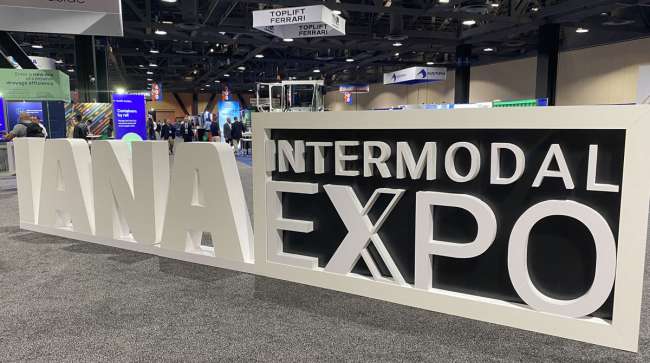Staff Reporter
Industry Leaders Praise FLOW for Improving Freight Predictions

[Stay on top of transportation news: Get TTNews in your inbox.]
The transportation sector can better forecast freight trends when companies share information, according to stakeholders of a government initiative aimed at facilitating that exchange.
Freight Logistics Optimization Works is a public-private partnership that aims to build a forward-looking, integrated view of supply chain conditions. Its data helps forecast how current capacity and throughput will fare against future demand. The Intermodal Association of North America hosted a panel on the initiative during its Intermodal Expo 2024.
“We’re fundamentally talking about better forecasting of disruptions or better forecasting of freight congestion,” said Andrew Petrisin, deputy assistant secretary for multimodal freight at the U.S. Department of Transportation. “What we’re doing, in a very literal sense, on a voluntary basis, is collecting information on future demand.”
Petrisin noted many companies are either looking at broad, historic industry data or their own select data. Either approach risks painting an inaccurate picture of the supply chain and where it’s headed. FLOW aims to fix this by getting carriers, shippers, terminal operators and other stakeholders to share information about their operations and expected incoming cargo through a mutual data aggregator.

Petrisin
“What we’re doing at the department is actually serving … as a neutral party to actually collect information that is both industrywide but also forward-looking,” Petrisin said. “We can really start to chip away at issues around forecasting in a way that I don’t think was possible before.” He added that the department leverages its commercial and operational independence, convening power and data privacy laws to facilitate this information sharing.
President Joe Biden and his administration launched the initiative in March 2022 as part of a broader effort to address supply chain vulnerabilities and congestion. The program has expanded significantly since then, with more companies becoming members. The data improves as membership grows, since participants must share their information. The Port of Oakland and the Northwest Seaport Alliance are among the newest members, having joined Aug. 13.
RELATED: USDOT Aims to Grow FLOW
Bryan Brandes, maritime director at the Port of Oakland, described FLOW as a revolutionary tool for forecasting future congestion in the U.S. He noted that while various data initiatives have existed for years, getting stakeholders to participate remains a significant challenge.

Brandes
“Everybody believes that their information is proprietary, somehow unique,” Brandes said. “They don’t want to share it.”
Even companies willing to share information may struggle, he said, if they’re not properly set up with electronic data interchanges or application programming interfaces. He noted the information they use could be inaccurate.
“This particular tool, it’s really complementing what we’re doing at the Port of Oakland,” Brandes said. “We’ve been doing some data initiatives that really focus on the trucker and moving ease of cargo in and out of the facility. This is going to be the next level, which really shows the best way to get cargo in and out of the U.S.”

(Bureau of Transportation Statistics)
The collapse of Baltimore’s Francis Scott Key Bridge on March 26 caused a major supply chain disruption. The incident occurred when a containership lost power and struck the bridge, causing it to collapse into the Patapsco River below, taking with it a construction crew and several vehicles. As officials and companies worked to mitigate the impact, FLOW proved to be a crucial tool in managing the fallout.
With the Port of Baltimore suddenly inaccessible, cargo had to be diverted to other East Coast ports, sending logistics managers scrambling to adjust their plans. The FLOW initiative quickly demonstrated its value in this crisis. At an annual FLOW members’ meeting in Washington, Petrisin received firsthand confirmation.
A supply chain leader from GE Appliances approached him and said, “‘Immediately when that happened, we started checking the FLOW data.’”
Want more news? Listen to today's daily briefing below or go here for more info:




